#mason dixon historical park
Explore tagged Tumblr posts
Text














That soft, otherworldly glow that lights up winter like no other season cast its spell over Dunkard Creek this morning. One of the loveliest hikes I've taken in many years.
#appalachia#vandalia#west virginia#pennsylvania#dunkard creek#mason dixon historical park#mason dixon line#winter#snow#ice#water#magic#joy#sycamore
62 notes
·
View notes
Text
Where In The World Is Phryne Fisher ?
This week finds Phryne in Lynchburg, Virginia.
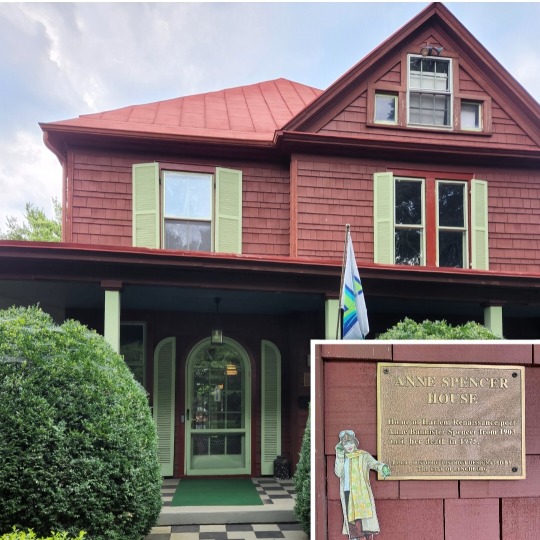
She started her visit in the Pierce Street Renaissance Historic District at the home of Anne Spencer, a Harlem Renaissance poet and the first black woman to have her work included in the Norton Anthology. She hosted many great Civil Rights leaders, including WEB DuBois and Dr. Martin Luther King, Jr.

Across the street is the home of her son Chauncey Spencer, who was an aviation pioneer, and his historic flight from Chicago to Washington DC convinced then-Senator Harry S. Truman to fight for blacks to be admitted to the Army Air Corps, and eventually create the Tuskegee Airmen.
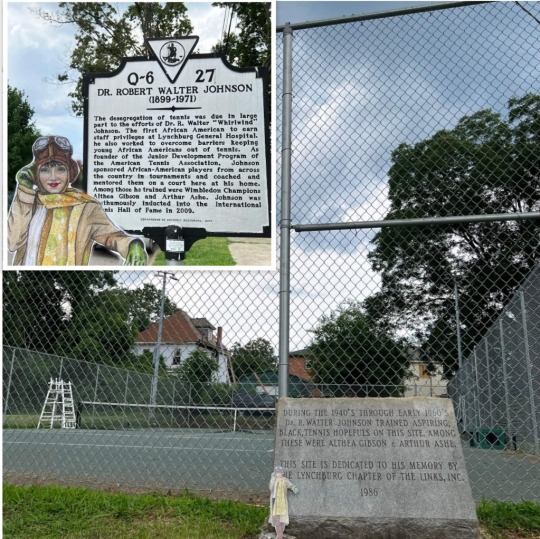
A little further down the street was the home of Walter "Whirlwind" Johnson and his grass tennis court, where tennis greats Arthur Ashe and Althea Gibson trained.

Phryne toured the Old City Cemetery, now a historic park that covers all sorts of history with restored historic structures relocated from around the region to provide a wide range of interpretation. One such structure is an old train station with a telegraph office. Lynchburg was a very busy railroad hub for a hundred years.
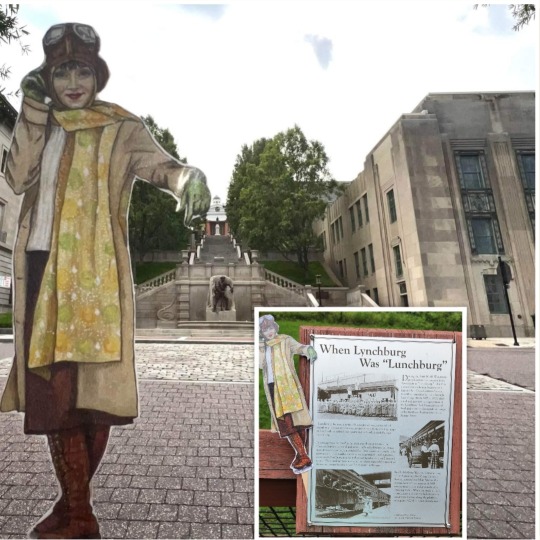
She stopped to pay her respects at Monument Terrace, built to honor those who died in World War 1, but along its 139 steps and various landings, monuments have been placed to recognize Lynchburg's fallen from all wars. At the top is Lynchburg's historic courthouse. And, YES, Lynchburg really does have hills that steep all over town! Speaking of railroads... During both World Wars, troop trains would pass through Lynchburg to pick up more soldiers, and local women's organizations would provide bagged lunches for the boys on the trains. Lynchburg became known as "Lunchburg"! Local veterans’ organizations hold a "Troop Rally" at the base of the steps every Friday at noon, rain or shine without fail, for 1076 weeks - over 20 years. We love our veterans in Lynchburg.

A close-up of the WW1 monument named "The Listening Post" - affectionately called "The Doughboy" after America's nickname for the enlisted men who fought in that conflict. If you zoom in, he kind of looks a bit like Jack, don't you think?
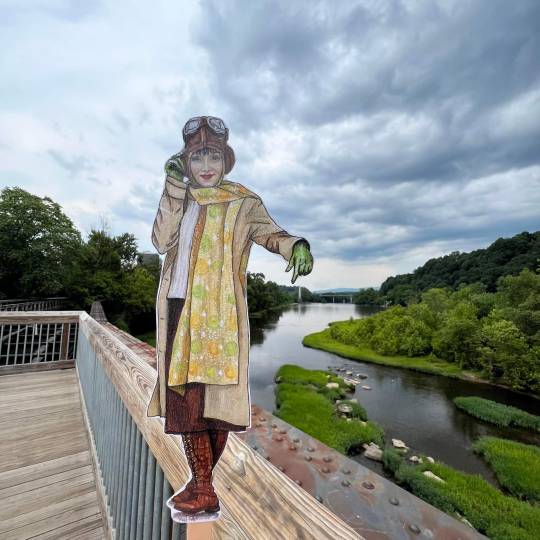
Lynchburg is situated on the James River, and was founded in 1757 by John Lynch, a Quaker who operated a ferry service across the river. By 1850, Lynchburg was the second richest city in America, after New Bedford, MA, with the river providing easy access to major coastal ports. The James River winds across the state, through the capital of Richmond, and eventually past Jamestown, where the first permanent English settlement in America was founded in 1607. Phryne was stopped from jumping in the river to cool off from a typically humid Virginia afternoon - there were still a few more places to see after all!
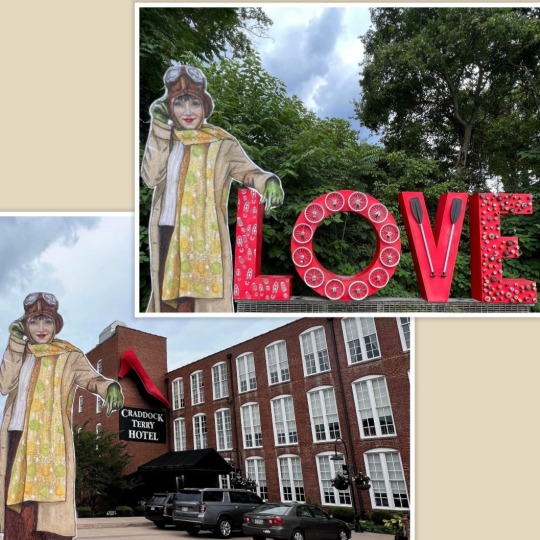
Virginia is for LOVERS, which delighted Phryne to no end, and she was thrilled to get a pic with Lynchburg's iconic LOVE sign (one of dozens across the state). This sign represents some of the ways you can enjoy the river and 40 miles of paved and unpaved trails in the city.
On the bluff above the river is the Craddock-Terry Hotel, an adaptive reuse of the old Craddock-Terry Shoe Factory. Founded in 1888, Craddock-Terry was the first shoe company south of the Mason-Dixon Line, and at its peak produced 100,000 shoes per day, from baby shoes to combat boots. Phryne was duly impressed!

Last stop of the day was drinks at the Skyline, the rooftop bar at the recently-renovated, art deco style, Virginian Hotel. A baked brie with pecan fig jam and some yummy cocktails were the perfect way to wind down after a busy day of touring.
Phryne is making her way to Miss Fisher Con 2022 in Louisville, Kentucky, August 4, 5, 6, 2022.
She hopes to see you there!
Information : www.missfishercon.com
#flatphryne #missfishercon2022 #missfishersmurdermysteries #missfisherandthecryptoftears #everycloudproductions #AcornTV
15 notes
·
View notes
Text
Charles Turner, Marcus Scott & Sean Mason in MELANIN or THE IN CROWD July 31, 2021 at Catskill’s Bridge Street Theatre
A Brand-New Musical in Concert at Catskill’s Bridge Street Theatre

Wrapping up a recent Artists’ Residency at the Catwalk Institute with pianist/composer Sean Mason and playwright Marcus Scott, Brooklyn-based vocalist and composer Charles Turner will present a one-night only “tasting” from the project they’ve all been creating together. This will be the very first airing of selections/songs from “Melanin or The In-Crowd”, an exciting new musical theatre piece in its nascent stages, to be performed live at Catskill’s Bridge Street Theatre on Saturday evening July 31 at 8:00pm.
Over the course of a weekend, a cadre of young, upscale, globetrotting professionals gather for one last hurrah in and around NYC’s lounge scene. Celebrating the newfound success of one of their own who has received a lucrative job offer overseas, the coterie spends an unforgettable weekend, touring various nightclubs in an endless cavalcade of booze, hookups and cheap thrills.
Inspired by the classic golden age MGM Hollywood musicals, but filtered through a modern lens, this splashy new musical encompasses a variety of musical styles such as blues, jazz, swing, big band, jazz fusion, progressive soul, psychedelic soul, cinematic soul, Sophisti-pop, quiet storm, urban, doo-wop, hip-hop soul, neo-soul, alternative R&B, funk, dancehall, reggae, highlife and afro pop. “Melanin or The In-Crowd” is a postmodern coming of age rom-com that explores themes including millennials and the youth of America, materialism, consumerism, capitalism and commodification, classism, colorism, selfishness, respectability politics, depersonalization and dating in the digital age, sexism, sexual freedom, and modern love, all through the prism of black bourgeois culture.
The multi-faceted Turner has performed at such venues as Dizzy’s Club Coca Cola at Jazz at Lincoln Center, Birdland, Smoke Jazz club and the historic Minton’s Playhouse in Harlem. International performances include PizzaExpress in London, Sunset/Sunside in Paris, Sala Clamores in Madrid, and other venues abroad from Seoul, South Korea to Wellington, New Zealand. His passion is to bring swing and jazz to listeners of all generations, carrying the Spirit of Harlem and the torch of the past into the present day for music lovers and dancers throughout the world to experience, embrace, and enjoy. This new collaboration with pianist/composer Sean Mason and playwright Marcus Scott extends Turner’s range even further and promises to be an event to remember.

Charles Turner is a multi-faceted, Brooklyn-based composer and vocalist whose work transcends borders and styles from Jazz, R&B to Soul. Turner has held residencies, hosted, and performed at venues such as Dizzy’s Club Coca Cola at Jazz at Lincoln Center, Birdland, Smoke Jazz club and the historic Minton’s Playhouse in Harlem. International performances include, Pizza Express, in London, Sunside Sunset in Paris, Sala Claomores in Madrid, and more venues abroad from Seoul, South Korea to Wellington New Zealand.
Turner’s Sophomore Album “ Single & In Love” , produced by Grammy award winning drummer Ulysses Owens Jr. has received critical acclaim and continues to play all across the world. Berklee College of Music Graduate, he has extended his educational value by teaching at The American School of Modern Music in Paris, France in 2017 & 18. Then then participated in “ Jazz for Young People” at JALC and conducted Masterclasses in various high schools and Universities such as N.Y.U.
Charles’ passion to bring swing and jazz to listeners of all generations and backgrounds proceeds through his new band and project Charles Turner & Uptown Swing. Bringing the Swing and Spirit of Harlem to music lovers and dancers around the world. Vibrant Swing , Virtuosic Bebop & Vital Blues, The band extends music from the swing era to present under the umbrella of swing .
Vocalist, Composer, & Educator, moving forward to bring this incredible music to the people ; Turner holds the torch of the past and brings it along with him to present day for all to experience , embrace, and enjoy.

MARCUS SCOTT is a playwright, musical theater writer, librettist, journalist, critic and teaching artist. Full-length works include “Fidelio” (Libretto; Heartbeat Opera at Baruch Performing Arts Center, 2018; called “poignant” by NY Times and “vital” by The New Yorker), “Tumbleweed” (Finalist for the 2017/2018 Humanitas Play LA Workshop, the Playwrights Foundation’s 2017 Bay Area Playwrights Festival, and the 2017 Festival of New American Plays at Austin Playhouse; semi-finalist for the 2017/2018 New Dramatists Princess Grace Fellowship Award), “Sibling Rivalries” (long-listed for the 2020 Theatre503 International Playwriting Award; semifinalist for 2021 Blue Ink Playwriting Award, the Landing Theatre Company’s 2020 New American Voices Playwriting Festival and the 2020 Campfire Theatre Festival), and “Cherry Bomb” (recipient of the 2017 Drama League First Stage Artist-In-Residence; 2017 Finalist for the Yale Institute for Music Theatre). His work has been developed, presented and/or produced by Joe’s Pub, Feinstein’s/54 Below, Abingdon Theatre Company, Astoria Performing Arts Center, Out of the Box Theatrics, Weathervane Theatre, Dixon Place, National Black Theatre (KSA series), Playwright’s Playground at Classical Theatre of Harlem, Space on Ryder Farm, Cherry Lane Theater (DUAF), Theater 80 St. Marks (DUAF), Across A Crowded Room – Lincoln Center Performing Arts Library (NYPL), NY Theatre Barn, CoLAB Arts, Symphony Space, NYC LGBT Center, Secret Theatre, MicroTheater Miami, among others. Residencies and retreats: The Center at West Park Virtual Performance Residency (2020-2021), Gingold Theatre Group Speaker’s Corner Writer (2020-2021), Liberation Theatre Company’s Playwriting Residency Fellowship (2018), Athena Theatre’s Athena Writes Playwriting Fellowship (2018), the inaugural LIT Council at the Tank (2018-2019), Fresh Ground Pepper Artist-In-Residence BRB Retreat (2017), One Co. Writers’ Residency at Little Farm (2017) and Goodspeed Opera House Retreat (2013). He was also the 2016-17 Musical Theatre Fellow at Playwrights Horizons and the 20172018 co-moderator of Musical Theatre Factory’s POC Roundtable. Scott is a four-time top finalist for the R&D Group at The Civilians, a two-time National Black Theatre I AM SOUL Playwrights Residency finalist and a 2019 finalist for the Bushwick Starr’s Starr Reading Series. His articles appeared in TimeOut New York, American Theatre Magazine, Playbill, Elle, Out, Essence, among others. BFA: State University College at Buffalo, MFA: NYU Tisch.

SEAN MASON. Born and raised in Charlotte, NC, Sean Mason taught himself by ear how to play the piano at the age of 13. His beginning musical roots included Gospel, Classical, Hip-Hop, and R&B music but then he discovered jazz and decided to make a career of it. To further his knowledge, Sean went to study music at The University of North Carolina at Greensboro. After two years of study, Sean decided to move to New York City and transfer his studies to The Juilliard School, studying for another two years before ultimately leaving to pursue his music interests independently. In his short but already groundbreaking career, Sean has played and toured with many jazz professionals, prominently including Branford Marsalis and Wynton Marsalis, but among many others. Sean is based in New York City and leads his own band, “The Sean Mason Trio”, which performs regularly in New York City and tours across the globe. Aside from his performing career, Sean is also a composer and an orchestrator in the musical theatre space. https://www.seanmasonofficial.com
#Melanin#The In Crowd#The In-Crowd#black musicals#musicals#WriteMarcus#Write Marcus#Marcus Scott#MarcusScott#Charles Turner#Sean Mason#Catwalk Residency#Catwalk Artist Residency#Catwalk Institute#Bridge Street Theatre#Catskills
2 notes
·
View notes
Text
USM’s Max Grivno to discuss Hernando De Soto at November 22 meeting of Natchez Historical Society
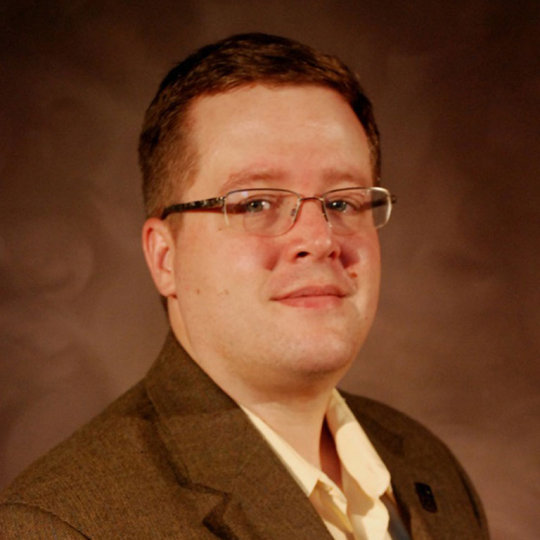
Dr. Max Grivno
University of Southern Mississippi
NATCHEZ, Miss. – Max Grivno, faculty member of University of Southern Mississippi, Hattiesburg, will talk about Spanish explorer Hernando De Soto at the November meeting of the Natchez Historical Society.
Grivno’s presentation is titled, "Hernando De Soto and the First European Contact with the Mississippi Civilization of the Lower Mississippi Valley." It will be given at 7 p.m. Tuesday, Nov. 22, 2022, at Historic Natchez Foundation at 108 S. Commerce St. The program will follow a social time set for 6:30 p.m.
Grivno said he is happy to be speaking again before the NHS.
“The lecture covers an important, but often overlooked, period in the region's history,” he said. “It shows not only the devastation caused by De Soto's raid in the southeast, but also considers how Native people built new societies in its aftermath."
Grivno is an associate professor at USM. He holds a Doctor of Philosophy degree from University of Maryland-College Park, where he also earned his master’s degree. Grivno completed his bachelor’s degree at St. Olaf College.
Grivno is the author of Gleanings of Freedom: Free and Slave Labor along the Mason-Dixon Line, 1790-1860 (University of Illinois Press, 2011); and Historic Resource Study, Ferry Hill Plantation (Forgotten Books, 2017). In addition to Mississippi History, his expertise is in Antebellum South, Slavery, Economic and Labor History.
For more information, visit http://natchezhistoricalsociety.org/67001.html.
#VisitNatchez #SouthernMiss
0 notes
Text
Before Rhode Island Built Its State House, a Racist Mob Destroyed the Community That Lived There
https://sciencespies.com/history/before-rhode-island-built-its-state-house-a-racist-mob-destroyed-the-community-that-lived-there/
Before Rhode Island Built Its State House, a Racist Mob Destroyed the Community That Lived There
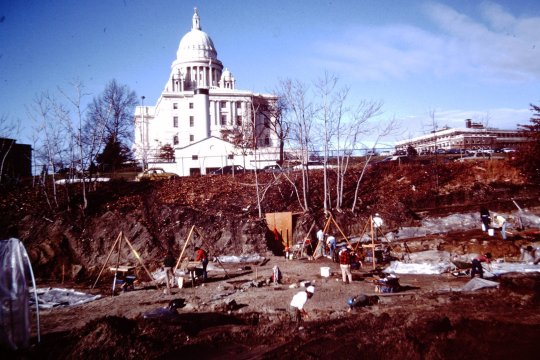
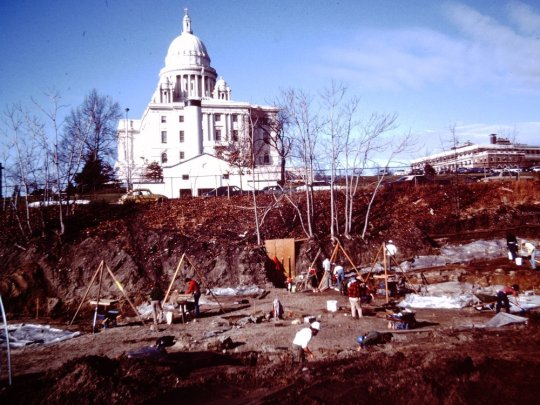
Photo of 1982 excavation at North Shore site Snowtown Project
On a pair of folding tables in the basement of the Public Archaeology Laboratory (PAL) in Pawtucket, Rhode Island, four metal trays display an unusual assemblage of artifacts. Humble ceramic tableware. Iron padlocks. Dominoes carved out of bone. A cut-glass tumbler. A diminutive bottle of French hair tonic. The headless body of a porcelain doll. A Spanish coin. A redware pot with drizzles of blue, black, yellow and green paint frozen in time on its sides.
These are the vestiges of Snowtown, a poor but vibrant mixed-race community that was once part of the state’s capital city, Providence. Moreover, it stood on the grounds where the state’s imposing capitol building now sits. Though no visible traces of the neighborhood remain, its history—including a deadly mob attack in 1831—is now being resurrected by the Snowtown Project.
The initiative began as an outgrowth of a Rhode Island State House Restoration Society subcommittee that was tasked with telling lesser-known stories about the capitol building and its grounds. Marisa Brown, who chairs the subcommittee and is an adjunct lecturer at Brown University’s John Nicholas Brown Center for Public Humanities and Cultural Heritage, says, “There’s a disconnect between the accuracy of what happened in the past and what our landscapes tell us. There are just too many places that we have lost.”
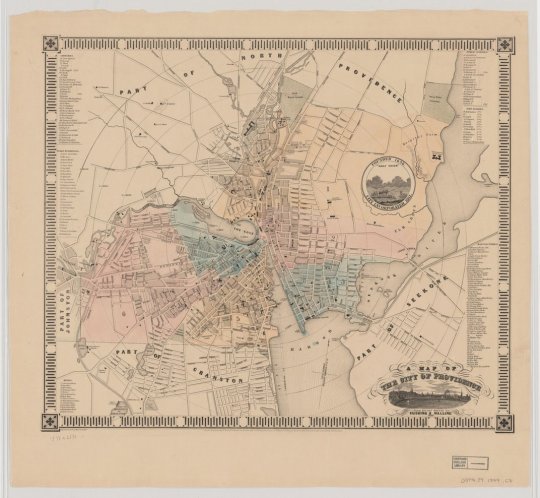
1849 map of Providence, Rhode Island. Snowtown stood just north of the Cove, near the center of the map.
Harvard University, Harvard Map Collection
In 2019, the subcommittee emailed colleagues to gauge interest in researching Snowtown. Over the course of three meetings, a handful of people blossomed first into a group of 30 and now a cohort of more than 100 historians, archivists, archaeologists, teachers, storytellers, artists and community members.
After the American Revolution, Rhode Island experienced rapid population growth driven by the international “Triangle Trade”—of enslaved people, sugar products and spirits—through the port of Providence. The state’s distilleries had a special knack for turning imported sugarcane and molasses from the West Indies into rum, which was traded for enslaved labor. But by the 1830s, as the population surpassed 16,000, the manufacturing of textiles, jewelry and silverware had supplanted the merchant trade as the city’s primary economic driver.
The state’s Gradual Emancipation Act of 1784 had allowed children born to enslaved women to be freed once they reached adulthood. Within decades, a new population of free Black people had emerged, but they, along with indentured servants, Indigenous people, immigrants and impoverished white people, were pushed into marginalized communities. Many of these groups were denied the opportunity to work in the burgeoning manufacturing industry.
They lived in places like Snowtown, a settlement of shabby homes and businesses with little in the way of conveniences. It was home to between two and three dozen households, but the population ebbed and flowed. Some residents toiled as domestic servants in the homes of Providence’s elite, or in trades like carpentry and sewing. The most successful owned small businesses or boarding houses. Even for the latter, life in Snowtown was difficult.
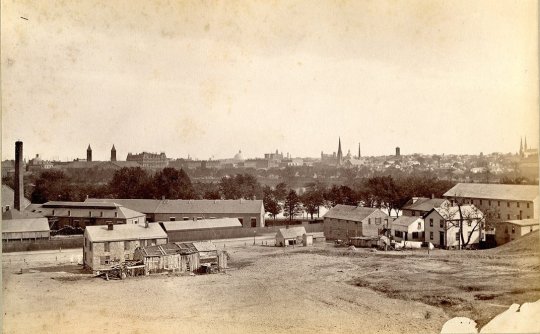
View south from Smith Hill with downtown Providence in the background and residential buildings in the foreground, 1885
Providence Public Library under CC BY-SA 4.0
Pollution in Providence made conditions even worse. The Great Salt Cove, a tidal estuary that had been significant to local Indigenous tribes, just below the sandy bluff where Snowtown was located, became a dumping ground for sewage and industrial waste. Real estate in the village was undesirable; rents were cheap; and “disreputable” businesses aimed at sailors coming through port—brothels, saloons and dance halls—proliferated.
In 1831, sailors newly arrived from Sweden aboard the steamer Lion started a brawl at a tavern in Olney’s Lane, a neighborhood adjacent to Snowtown that was also home to an assemblage of non-white communities. According to an account in the Rhode Island American and Gazette, the sailors gathered reinforcements and attacked a home occupied by “blacks of a dissolute character.” Two Black men fired on the sailors, slaying one and wounding three. The white mob, shouting “Kill every negro you can!” advanced uphill into Snowtown, where the shooter was believed to had fled.
Over the course of four days, 18 buildings in Snowtown and Olney’s Lane were damaged or destroyed. Eventually, the state militia, ill-equipped to handle the scene, fired to disperse the mob, killing four.
Though residents rebuilt, by the late 1800s, Snowtown and its Black residents had been displaced by industrial progress. Rhode Island had grown into the wealthiest state per capita. In part as a monument to its prestige, the state commissioned renowned architects McKim, Mead & White, of Pennsylvania Station and New York Public Library renown, to design a massive State House on the bluff above Great Salt Cove. Construction was completed in 1904.
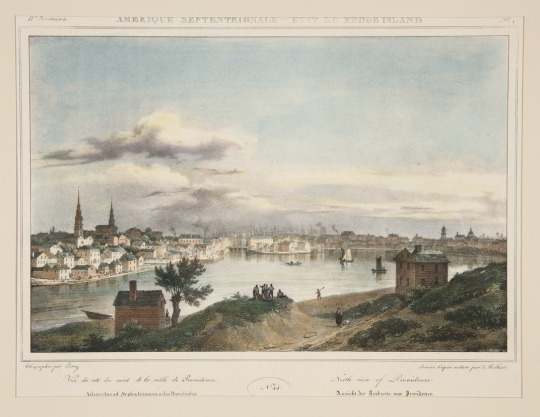
1828 lithograph showing view looking south from Smith’s Hill, with some of the buildings along the north shore of the Cove in the mid-ground
Yale University Art Gallery
Today, all traces of Snowtown and its sister communities are obscured beneath railroad tracks, a small park commemorating state founder Roger Williams, and the ornate neoclassical capitol and its rolling green lawns.
Still, says Chris Roberts, a Snowtown Project researcher and an assistant professor at Rhode Island School of Design, “If you’re researching slavery in Providence, Snowtown comes up. If you’re looking at the history of women in Providence, Snowtown shows up. If you’re looking into the city as a commercial hub, it comes up. Snowtown is a character in so many different histories of the city.”
Uncovering Snowtown has not been without challenges. For starters, the record is incomplete. Census data, for example, documents the names of heads of households, with only numbers to indicate women and children. “We often have to grapple with these archival silences,” says Jerrad Pacatte, a Snowtown research committee member and a PhD candidate at Rutgers University. “These were people who were not considered worthy of being counted.”
Physical evidence of entrepreneurship, creativity and personal care persist in a collection of about 32,000 artifacts. The artifacts were unearthed, and about 30 percent cataloged, in the early 1980s, when the Federal Railroad Administration undertook rail-improvement projects in the Northeast, including in Providence.
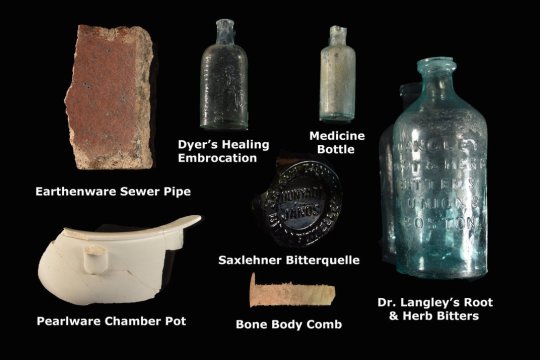
Assorted artifacts found during digs in the Snowtown neighborhood
Snowtown Project
According to Heather Olson, the lab manager for PAL and a Snowtown Project researcher, the materials were then archived and shipped to what is now the Rhode Island Historical Preservation and Heritage Commission. They remained there for 35 years, largely untouched, save for a few inquiries related to doctoral theses and a small exhibit in 1988; those items subsequently went missing.
The remaining artifacts were turned over to the PAL in 2013. The organization has digitally cataloged the entire collection—everything from writing slate and pencils to crucibles for metal working, woodworking tools and children’s toys. (Some of these digitized objects will hopefully be publicized online when the project is completed.)
Kitchen items are the most common, and they reflect a curious intermingling of status. Alongside unadorned plates and servingware, the collection includes pricey Blue Willow transferware, Chinese porcelain and an 18th-century feldspathic stoneware teapot. Olson says, “I don’t know if these arrived as clean fill from somewhere, if it was something bought secondhand, or if this was something that had been given to the people”—for example, to a domestic servant employed by the city’s wealthy.
Other artifacts give clues about the residents’ health. The large number of bottles for digestive tonics, for instance, speaks to the contaminated nature of the water supply. For Olson, the collection is an opportunity to examine a hidden history. “What can you identify? What can you say about people who were, for the most part, invisible?” she says.
If the complex work of the Snowtown Project shines a spotlight on a single truth, it’s that “written history belongs to the winners,” says Joanne Pope Melish, a retired University of Kentucky historian; the author of Disowning Slavery: Gradual Emancipation and “Race” in New England, 1780–1860; and co-chair of the project’s research committee.
“History, and the doing and the telling of history, is a product of the politics of the moment in which the telling of the story is happening and of the moment in which the story took place,” she explains.
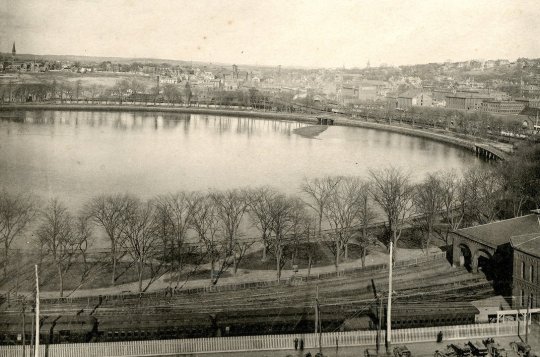
Rooftop view of Providence from City Hall, looking north over railroad tracks, Providence Cove, and buildings in the distance, circa 1880. Snowtown is visible in the distance at top left.
Providence Public Library under CC BY-SA 4.0
White supremacy was alive and well above the Mason-Dixon Line. Newly freed African American people traded the physical oppression of enslavement for the societal oppression of classism and historical effacement. Mentions of Snowtown are infrequent in contemporaneous newspapers. They begin to reemerge only in the 1960s, as the civil rights movement brought the neighborhood back into public consciousness.
This awareness has accelerated over the past decade, in direct response to the Black Lives Matter movement. Modern media retellings of vanished histories have also helped, such as the episode of HBO’s “Watchmen” that dramatized the events of the 1921 Tulsa Race Massacre.
Before Tulsa, according to Pope Melish, white mobs attacked northern Black neighborhoods 144 times between 1820 and 1850. While the Oklahoma attack was far deadlier, these assaults present two sides of the same coin. Pope Melish says, “It parallels the impossibility of being a ‘perfect’ enslaved person or free person of color. If you’re poor, you’re disgusting. If you’re successful, you’re uppity. Both cause hostility.”
Traci Picard, a public historian who co-chairs the Snowtown Project research team, has been working to unearth personal histories. She has sifted through thousands of seemingly mundane materials, including writs and warrants—an early version of small-claims court. “Every single thing is built by someone,” she says. “I don’t mean designed by someone, or who gets the credit for building it. Every single block, every single brick, every single building—we’re surrounded by people’s lives and experiences and stories.”
Planning is underway to present those stories in an exhibition at the State House, as well as a digital publication featuring maps, photos and documents. Snowtown History Walks debuted in June, and public art installations and signage for self-guided tours are also being discussed.
Playwright and actor Sylvia Ann Soares, a programs team member and a Cape Verdean descendant of the Portuguese slave trade in Providence, is working on a Snowtown-themed play set to premiere next year. She believes that involvement of artists in the earliest stages of the project is integral to its retelling. “The results will be richer,” she says. “Many people will not read a scientific journal or go to a talk, but if it’s dramatic, if there’s some music, some songs of that era, it brings it alive.”
Soares adds, “I intend to [use the play to] speak out as an inspiration for advocacy against present-day injustice.”
For Pacatte, it’s also an opportunity to broaden our understanding of a part of American evolution that has been swept under the carpet of white history. “Snowtown is a microcosm for the very messy and prolonged process of emancipation that people in the North experienced before the Civil War,” he says. “It’s the story of African Americans [in the U.S.]: They were resilient and kept rebuilding their lives.”
African American History
American History
Death
Digitization
Exhibitions
Indigenous Peoples
Industrial Revolution
Maps
Race and Ethnicity
Racism
Slavery
#History
0 notes
Text
‘Back to school’ means anytime from late July to after Labor Day, depending on where in the U.S. you live
‘Back to school’ means anytime from late July to after Labor Day, depending on where in the U.S. you live;

First-graders quietly head into the cafeteria at Tulip Grove Elementary School in Bowie, Maryland, on Sept. 4, 2018. The district is among the 22% of public school districts that start classes after Labor Day. (Marvin Joseph/The Washington Post via Getty Images)
It’s the second full week of August, which means millions of American schoolkids are heading back to school or have already started. And depending on where you live, that statement might produce a reaction of either “That sounds about right” or “That seems way too early!”

Back-to-school dates in the United States, it turns out, vary considerably by state and region, based on our analysis of a sampling of the nation’s 13,000-plus public school districts. By the end of this week, for example, nearly all elementary and secondary school students in the East South Central region – a Census Bureau division that includes Alabama, Kentucky, Mississippi and Tennessee – will be back in school. But not a single district in the nine New England and Middle Atlantic states will resume classes before Aug. 26, and many wait until after Labor Day.
The prize for the earliest start date among the 500-plus districts in our sample goes to Arizona’s Chandler Unified School District, which serves part of suburban Phoenix. The 44,000 or so students in Chandler Unified went back July 23 (though they get the first of three two-week “intersession” breaks starting Sept. 30). At the other extreme are the Trenton, New Jersey public schools, whose nearly 14,000 students won’t go back to school till Sept. 9 – the latest opening date in our sample.

Broadly speaking, earlier starts are more common in the South and Southwest: In a rough band of 13 states stretching from Arizona to Florida and up to South Carolina, 79% of the districts we examined will be back in school by the end of this week. Later starts are more common along the East Coast (from Maine to North Carolina), the upper Midwest (Wisconsin, Minnesota, Michigan) and the Northwest (Oregon and Washington).
Historically, the tourism and hospitality industries have favored later back-to-school dates, arguing that they give families more time to take vacations and teenagers more time to work summer jobs. For example, since 1986 Virginia’s “Kings Dominion law” (named for the amusement park just north of Richmond) barred most schools in that state from opening before Labor Day. Earlier this year, the law was amended to permit districts to open up to two weeks earlier, so long as they also give students a four-day Labor Day weekend. Still, six of the 10 Virginia districts in our sample are starting their 2019-20 school years after Labor Day; two will open Aug. 26, one on Aug. 22, and one (subject to a special provision) on Aug. 12.
To get a sense of when students head back to school, we looked at the 10 largest local school districts by enrollment in each state (except for Hawaii and the District of Columbia, which have only one district apiece). We also examined additional districts in Texas, Florida and California, so that the final 509-district sample would include the nation’s 100 biggest districts. We excluded private and parochial schools, public charter schools, state-run schools and other educational institutions that often operate on their own schedules. Our final sample covered about 36% of the nation’s 50.6 million public elementary and secondary students.
For each district in the sample, we determined the date or dates on which most of their first-through-12th graders started fall classes. (Kindergartners often start school later than their older peers.) Although a handful of districts are on some form of year-round schedule, and many others have individual schools that operate year-round, we focused on the “traditional” calendars followed by most schools in a given district. When start dates were staggered by school or grade level, we used a date range.
All told, 124 of the districts in our sample (representing 29% of students) are starting school between Aug. 12 and Aug. 16, making it the most popular start week. Another 74 districts (with 14% of students) went back earlier this summer; 93 (19% of students) will start up again next week.
But 105 districts (14% of students) won’t start until the last week of August – and nearly half of these (48) are in New England or the Middle Atlantic states (New York, New Jersey and Pennsylvania). An additional 113 districts (with 23% of students) won’t resume classes till after Labor Day, all but 22 of which are north of the Mason-Dixon line. (The 22 exceptions are in nearby Delaware, Maryland and Virginia.)
Are students going back to school earlier than they used to? Finding school calendars from years and decades past for our sample districts proved to be beyond the reach of this analysis, but there’s some evidence that more secondary-school students, at least, are spending part of their summers in the classroom.
A separate Pew Research Center analysis found that U.S. teens are spending more of their summer hours on educational activities – and less time on leisure – than they used to.
; Blog – Pew Research Center; https://www.pewresearch.org/fact-tank/2019/08/14/back-to-school-dates-u-s/; ; August 14, 2019 at 01:25PM
0 notes
Text
Mason & Dixon's “Post Mark'd West” History Hike
The Mason Dixon Line often cited in reference to the Civil War was really a survey to mark two large landholders' properties.

The land that is today known as White Clay Creek State Park includes parts of the boundary line made famous by Mason and Dixon, who began their historic survey at “a post mark’d west,” a location that lies within the park. Join us on a moderate hike to this historic marker. Bring plenty of water.
Mason & Dixon's Post Mark'd West History Hike Free Sunday, March 10, 2019 at 1 p.m. Meet at the Possum Hill Parking Lot Guest Speaker: Mike Ott. Space is limited, pre-registration is required by noon, Thursday, March 8. (302) 368-6900
Way Back in the late 1700s, Delaware, Maryland, and Pennsylvania landowners struggling over the boundaries between their properties, and the States. They argued, than hired two surveyors to mark the lines. These two men, were Jeremiah Dixon and Charles Mason, became more famous ever hear of them? Not to many know about these ruins in the Delaware woods that are older than our country itself. In White Clay Creek State Park, you'll find a trail with some hiding legendary ruins. Take Bryan's Field trail cross the creek, go through the woods, as you walk you'll find yourself stepping back time of Delaware's history. This is were you'll find “a post mark’d west”. This is the cornerstone where Charles Mason and Jeremiah Dixon began their famous survey of the boundary between Delaware, Pennsylvania and Maryland. The way the line is drawn makes Delaware the only state east of the Mason Dixon Line. In 1849, a joint boundary commission engaged Lt. Col. J. D. Graham of the US Corps of Topographical Engineers ( later incorporated into the US Army Corps of Engineers) to re-survey the North and Arc Lines. Graham validated Mason and Dixon’s survey of the relevant line segments with a few minor adjustments, and set a three-sided stone at the intersection of the North Line and the Circle, affirming Pennsylvania’s claim to the Wedge. Delaware protested the result. In 1889, the two states agreed that the Wedge belonged to Delaware.
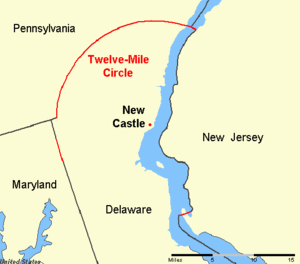
You may also want to take a hike along the Twin Valley Trail, while you are there, to find the Arc Monument, this marker exact position of the borders in Pennsylvania and Delaware along William Penn's 12 Mile Circle. The boundaries of the circle were the focal point of the eighty-year Penn–Calvert Boundary Dispute. The fact that the circle extends into the Delaware River makes for an unusual territorial possession. Find maps of the Bryan’s Field Trail here - White Clay Creek Trails
Looking for something to do in Delaware follow Out With Friend in Delaware …
… Looking for someone to hang with? Join our group and find new friends.
0 notes
Text
42 Holdings, 5 Purchases, 4 Sells.
Family summer getaway in Kentucky uses a great deal of excellent visitor locations for all type of individuals along with a wide array from enthusiasms. The weirdest point was recording a black sphere that exact same night in my space soaring all around with orange sunlight going over that. I had nothing brand new in my lifestyle then except visiting that parish thus i think going there is just what triggered that shadow man to seem, simply i do not know if this was actually an advantage or even unsatisfactory slim but i carry out understand its own certainly not go back. To avoid including addictive characters to your life take into consideration the truth from the people you decide to relate to. " 1. Dark skin will minimize your chances from receiving robbed walking down the road compared to a white man. Function due to the public and doubters then was combined, but most failed to like the film. I consulted with a nearby around 4:30 p.m. Sunday, after kayaking on the Elk Waterway, after experiencing the same feeling sitting in their parking area and also plainly this isn't really the very first time this has actually happened. Father Porker: OK, George, you can possibly do the newspapers. Compared to the later ordeal from War of the nations 2, films set in the First War of the nations are sparse on the ground, and movies which feature the daring pioneer aviators from that battle rarer still. The encounter smashed me as well as I never publicly danced once again and it specified right into movement a life-time really worth from physical body dysmorphia. Because of click this site i feel anybody from any skin layer colour need to have the capacity to comment on any type of social concern they experience should talk about. i'm certainly not trying to challenge the life adventure from any sort of indigenous musicians, i only think that in this time someone that really isn't from Indigenous background can effortlessly have actually an educated understanding of the discrimination experienced by Indigenous Australians unprejudiced to some Aboriginal Australians. During the 19th century, the waterway was actually the southern perimeter of the Northwest Territory This is at times taken into consideration as the western side expansion of the Mason-Dixon Line that split Pennsylvania coming from Maryland, as well as thus part of the border in between complimentary and also servant territory, and also in between the Northern and also Southern United States or even Upper South Where the stream was slender, this was the method to liberty for hundreds of servants escaping to the North, lots of assisted through complimentary blacks and also whites from the Below ground Railroad protection motion. Her perspective of her people's change was actually altered through some of her very own family, nevertheless, lucky also darker. My partner and I are record fans, so our team pass links to articles on past history sites and also on historical discoveries. " Equality" seems fantastic up until you understand God actually did certainly not make all men equal, nor did he create all ladies equivalent, nor are ladies actually equal to men, regardless of the amount of our society persuades individuals to do that. A white authority figure is actually not visiting succeed along with black folks without help off dark authority bodies. Protein can be increased by including a protein-rich food like grilled hen, fish, healthy red pork or even eggs to the rice meal. In the end of the day it continued to be the greatest pressure once and for all on Calernia, and also though its own past history was full of mistakes as well as problems Procer was exactly what maintained the area with each other. While our company are actually usually not ones to savor the misery from others (well, at times ), our team feel urged to share this online video of Gamespot staffer Alex Navarro consuming crow.

And also here is my proof about the whole factor, when my Uncle Sank was resigned he told my Uncles and also my father that they brand new Travis resided in Concho after the fact however there was actually alot of male energy invested in searching for him for the week he was actually gone as well as there was actually alot from loan being taken into the area concerning the entire challenge so they only permit it be, as well as Travis has created alot of cash on his experience, however trust me individuals his Family looked at hell coming from critism coming from the town individual and his poor son Clifton was ridiculed ruthlessly throughtout school, which I new clifton as well as I liked him, however he brand-new who my uncle was actually and my uncle was actually the James Gardner person in the motion picture, as well as my uncle always was critical of Travis, so I might inform clifton didnt like my uncle. My mother told me this tale however seemed so real to her and after she told me that. She told me exactly how close April as well as her were actually. Madame Gazelle: Children, today our experts have a brand-new pupil, Peppa Porker. Her felines adore it and spend a ton of opportunity playing and relaxing in that.
0 notes
Text
Dunkard Creek at Mason Dixon Historical Park earlier this morning.
#appalachia#vandalia#west virginia#winter#snow#ice#dunkard creek#pennsylvania#mason dixon historical park
34 notes
·
View notes
Text
2019 Pride Rally
Loud, Proud and Virtual: If the 50th anniversary NYC Pride March has been canceled due to COVID-19, this year’s LGBT+ Pride Week events are as varied as the community, from rallies to parties to cooking shows to gay neighborhood tours – and lots of theater. Many of these events require advance registration; most are free. All are online. (The pictures above are from previous years.)
Ongoing Productions
The Absolute Brightness of Leonard Pelkey. 92nd Y Through June 30
Jemima Jones: Black Light
Criminal Queerness Festival Dixon Place. Bringing together renowned queer playwrights from around the world, from countries that treat them like criminals. Through June 29
Pride Music Video festival
10 world premieres from the feath3r theory and the Invisible Dog released weekends throughout June
“PRIDE is actually NOT a parade, it is NOT a circuit party, and it AIN’T a Carley Rae Jepsen or Beyonce secret release. PRIDE is a celebration of the culture that we make and put out into the world so that the world can celebrate us.”
The Queerly Festival FrigidNY. Through July 2
Monday June 22
6 p.m. The Garden Party at the LGBT Center kicks off Pride Week, as it does every year, but this time it’s virtual – offering appearances and performances, a playlist, and even recipes for “delicious bites and beverages that you can craft from home”
6:30 p.m. Savor Pride: Chef Kate Pelayo, Sous Chef at TAO in Los Angeles, will showGinger honey glazed salmon. The first of this culinary web series through June 27
7 pm Brave Smiles…Another Lesbian Tragedy, from the Five Lesbian Brothers, on Playbill’s Pride Plays page
8 p.m. Criminal Queerness Festival: The House of Joy. Roger Q. Mason and Ianne Fields Stewart lead an evening of art-based connection and queer community building.
8:15 p.m. Queerly Festival: Big Gay Love Story, The Musical
9:30 p.m. Queerly Festival: It’s Not Me, It’s You A queer take on the story of Lucifer’s fall from grace and the War in Heaven
Tuesday June 23
2 p.m. The Gay Pride (Online) Tour of LGBT History in Greenwich Village. $10
6:30 p.m. Savor Pride: Chef Renee Blackman, born and raised in Barbados, Chicken thighs seasoned with ginger and cilantro Confit potatoes and charred broccoli
7 p.m. Criminal Queerness Festival: Panel on LGBTQ human rights in Latin America
Wednesday June 24
6:30 p.m. Savor Pride, Amanda Freitag, author and food TV personality, Lamb Burger with Mint Yogurt
7 p.m. Queer Fiascos! Share your story on the theme of queer fiascos (if you want), and listen to others share theirs.
7 p.m. Queerty Festival: Blessed Oil and Brown Liquor From brown liquor-fueled basement parties, and spirit-filled churches: A black queer journey.
Pride Run.
For 38 years, Front Runners NY has organized a 5-mile race to celebrate LGBT Pride. This year’s LGBT Pride Run, historically taking place in Central Park, has been transformed into a virtual 5-mile race.
Thursday June 25
9:30 am – 6 p.m.Human Rights Conference A series of panel discussions and breakout sessions (it begins with an online workout session)
7 p.m. Queerty Festival: Coming Out, A New Musical
7:30 p.m. Savor Pride: Chef Sicily Sierra, co-founder of Pinky & Red’s and Chef Mavis-Jay Sanders, director of operations at The Brownsville Community Culinary Center: Pan-seared fish with green sauce and white bean salad
Falsettos
8 pm Falsettos Live From Lincoln Center has teamed with the subscription service BroadwayHD for a free screening of the 2017 production of William Finn and James Lapine’s pioneering gay musical that follows Marvin, who left his wife to be with a male lover, and his friends and family, portrayed by Christian Borle, Stephanie J. Block, Andrew Rannells, and Brandon Uranowitz. Available for 48 Hours
Friday June 26
5 to 8 p.m. NYC Virtual Pride Rally with trans journalist Ashlee Marie Preston and trans actor Brian Michael Smith as hosts
7 p.m. Global Pride 2020 24 hours of performances and speeches!
7 p.m. The Men from the Boys. Mort Crowley’s sequel to The Boys in the Band, showing what happens to the characters, directed by Zachary Quinto and shown on Playbill’s Pride Plays page
7 p.m. Criminal Queerness Festival: vichitra: an anthology of queer dreams
8 p.m. Queerly Festival: The Reparations Show, a variety show that will center stories created by and about Black and Indigenous artists. Kevin R. Free is the host at this performance.
Saturday, June 27
2 p.m. The Bloomsbury Set and Queer Soho: a tour of London’s gayest neighborhoods/ $10
3 p.m. PrideFest 2020 Brooklyn’s second annual concert, on two virtual stages
4 p.m. Family Pride Dance Party
6:30 p.m. Savor Pride Chef Liz Alpern, creator of Queer Soup Night,
7 p.m. Masculinity Max. A play by MJ Kaufman, directed by Will Davis and shown on Playbill’s Pride Plays page
8 p.m. Queerly Festival: The Gay Card. Three young gay men are searching for love and connection
Sunday, June 28
6 to 9 p.m. On Top of the World, a Global Pride Celebration. Tickets $10 – $35
7 p.m. The Night Larry Kramer Kissed Me, at Provincetown Playhouse. A streaming of the 2013 production of David Drake’s play, featuring Drake (who initially performed it in the 1990s as a solo show), André De Shields, BD Wong, Robin De Jesús, Rory O’Malley, Anthony Rapp, Wesley Taylor, Chad Ryan, Donald C. Shorter, Jr., Aaron Tone, Brandon Cordeiro and Claybourne Elder
7 pm Criminal Queerness Festival Maid in America Conceived by and starring Migguel Anggelo
Pride Week 2020 Calendar of Events: LGBTQ Theater, Festivals, Festivities Loud, Proud and Virtual: If the 50th anniversary NYC Pride March has been canceled due to COVID-19, this year’s LGBT+ Pride Week events are as varied as the community, from rallies to parties to cooking shows to gay neighborhood tours – and lots of theater.
1 note
·
View note
Text
Bernie's first big test of 2020 arrives
New Post has been published on https://thebiafrastar.com/bernies-first-big-test-of-2020-arrives/
Bernie's first big test of 2020 arrives
Sen. Bernie Sanders. | Patrick Semansky/AP Photo
LAS VEGAS — Free tacos. Agua de jamaica. A futbol tourney.
Bernie Sanders’ “Unidos con Bernie” event Monday was unlike any other hosted by his rivals in Nevada, where polls indicate he’s leading among Latino voters.
Most of the kids playing were too young to participate in state’s caucuses on Saturday. But Chuck Rocha, a senior adviser and point man for Sanders’ aggressive courtship of Latino voters in the state, said that was beside the point.
“I can’t guarantee that every young man out there is old enough to vote, but every young man out there knows that we’ve been in this community for eight months,” Rocha told POLITICO on the sidelines. “And they’ll be talking to their friends who can go vote, and go home to their parents and talk about Bernie Sanders buying everybody food while we played soccer [and] watch[ed] over their children while they were here in this park.”
Nevada presents the first test of Sanders ability to turn out Latinos. If he does well among the key demographic — which could account for 20 percent of caucus-goers — it could provide a recipe for continued success among Latinos on Super Tuesday, in states such as California, Texas, and North Carolina.
The campaign says it’s spent millions on Latino outreach in Nevada. Of the 250 staffers in the state, more than 100 of them are people of color and 76 are Latinos. Sanders is targeting Latinos on digital platforms like YouTube, Hulu, and Pandora; with mailers, TV ads, phone calls, and texting; and via old-fashioned door-knocking and community events. The campaign has held 35 of those in Spanish.
Polling backs up Sanders advisers’ confidence that the efforts — crafted with the knowledge of their 2016 missteps in mind — will pay off in the first nominating contest with a diverse voting population.
In a pair of polls released Tuesday, Sanders and Joe Biden placed first and second among Latinos. A Univision poll conducted Feb. 9-14 had Sanders ahead, with 33 percent support among Latinos compared to 22 percent for Biden. A Telemundo poll conducted Feb. 10 – 12 showed Biden at 34 percent among Latinos vs. 31 percent for Sanders — although the pollster believes Sanders is now ahead because of the bounce he got from winning New Hampshire.
“He’s put in the work,” Laura Martin, executive director of the Progressive Leadership Alliance of Nevada, said of Sanders. Martin said she was stunned by the number of people Sanders’ campaign was busing to early voting locations last weekend. Martin also credtied the Sanders campaign work in securing endorsements from national progressive Latino groups that have helped bolster his ground game in states like Nevada.
Sanders has been on Spanish-language TV for the past six weeks, spending more than $130,000 in the final month. Only billionaire Tom Steyer has invested more, dropping more than $200,000 during that span. Steyer also went up with ads earlier in December.
Biden, whose campaign is predicting a second-place finish in Nevada, is the only candidate who is not on Spanish-language TV in the final stretch. According to a campaign source with knowledge of Biden’s paid communication strategy, Biden’s Latino supporters in Nevada primarily speak English as their first language and are older than 40, while his percentage of Spanish-speaking supporters ranks in the mid-single digits.
“Latino voters are paying attention and Bernie got a bounce from New Hampshire,” said Brad Coker, who conducted the Telemundo/Mason-Dixon poll. “Biden’s going to need to win two-thirds of Latino voters to win Nevada, anyway. And he doesn’t have that.”
Biden’s campaign and surrogates deny they’re ceding the Latino vote.
Rep. Filemon Vela (D-Texas) canvassed for Biden over the weekend in minority neighborhoods around Las Vegas. He said he’s sensing “overwhelming support for Biden” among Latinos 40 and over, based on his conversations with voters.
Also, some pollsters question the depth of Sanders’ support among Latinos in Nevada and elsewhere.
Stephanie Valencia of the Latino-focused Equis Labs, said it remains to be seen whether it’s Sanders “the candidate” or the broader “movement” he’s leading that attracts Latinos. Her polling reflects Sanders’ strength among the demographic, especially young Latinas.
“Do people who are Latino Bernie supporters feel so strongly about him that they’re going to show up and caucus for him?” Valencia said. “Because it’s one thing to show up and vote for somebody, it’s another thing to go and caucus for somebody.”
But Sanders’ campaign is acutely aware that his polling strength among young Latinos won’t necessarily translate in a caucus state like Nevada, given the time and effort required of voters. Young voters, regardless of race, are historically the least likely group to turn out.
That’s why his campaign said starting early was crucial. In 2016, his advisers didn’t realize Sanders’ potential with Latinos until late, said Rocha. Everything was “moving so fast, we never had time to go build our relationships in that community,” he said.
“We wanted to start the campaign where we left off, so we started in the Latino neighborhoods,” Rocha said. The first of 11 field offices it opened in Nevada was in the largely Latino East Las Vegas. And the first TV ads Sanders purchased in the state were in Spanish. “We’re blowing people out organizing-wise,” Rocha said.
Ironically, part of the campaign’s effectiveness among Latinos stems from the fact that it did not create a separate arm for courting Latinos, said Analilia Mejia, Sanders’ national political director. Instead, outreach to Latinos was integrated into every part of the organization. No matter the topic of a press release, Mejia said, a Latino staffer has looked at it before it goes out.
One of Sanders’ first messages to Latinos in Nevada came in an August mailer that told the senator’s family immigration story. That was followed by issue-specific mailers, including one in November prominently featuring progressive star Rep. Alexandria Ocasio-Cortez (D-N.Y.). Ocasio-Cortez held a town hall for Sanders in December entirely in Spanish, a rarity that drew widespread notice in the Latino community. Notably, Ocasio-Cortez is not scheduled to campaign for Sanders in Nevada in the final days before the caucuses.
Sanders’ final Spanish-language TV ad to Latinos this week was narrated, written and produced by Dreamers on his staff, according to the campaign.
Sanders’ rivals are trying to loosen his perceived grip on Latinos. Pete Buttigieg, Elizabeth Warren, and Amy Klobuchar all joined Sanders and Steyer on Spanish-language airwaves in the past two weeks. Warren met with the Latino organizing group Mi Familia Vota and held an event with Culinary Union workers. She’s also been joined by Julián Castro, a top Latino endorser, throughout the week.
Buttigieg campaign co-chair Nelda Martinez, a Texas mayor, is scheduled to campaign in Nevada this week. Buttigieg, Steyer and Klobuchar sat down with Telemundo in Nevad for a presidential townhall last week as Sanders tele-conferenced in.
Sanders’ biggest vulnerability among Latinos and all Democrats — attacks on him by the state’s powerful Culinary Union — was likely mitigated by the union’s decision not to endorse another candidate.
“The fact that [Culinary Union] chose to stay neutral means they’re essentially allowing Latinos to make their own decision on their own,” said Andres Ramirez, a Nevada political consultant. “Had Culinary endorsed Biden or Klobuchar, then I think it would have made a big difference.”
Marc Caputo contributed to this report.
Read More
0 notes
Text
Calvert County Maryland Building Codes California
Contents
Roadway safety professional capacity building information
1000 residents) maryland
Fiscal year (fy) 2015
Maryland building industry
County maryland lexington
25 structures visitors
Federal Department of Transportation/FHWA website to present roadway safety professional capacity building information
Calvert County Maryland Real Estate Compton Calvert County Maryland Tourism Callaway 2 Annapolis. America’s Sailing Capital (not to mention Maryland’s capital city) is a charming historic town with a serious sailing
All Cities; US states; Maryland Very Small Towns and Villages (fewer than 1000 residents) maryland Very Small Towns and Villages (fewer than 1000 residents)
Calvert County Maryland Map Saint Marys City A new bridge over the Chesapeake Bay could begin on the Western Shore anywhere between Harford County and St. Mary’s County, according to maps of
I recognize that,” Zyontz, 66, said one recent afternoon in his small office on the fifth floor of the County Council building in Rockville … land), a white wig (for George Calvert, the first Europe…
This page provides the status of the Pre-Disaster Mitigation (PDM) planning and project subapplications that were submitted to FEMA for the fiscal year (fy) 2015 application cycle.
Frederick is a city in, and the county seat of, Frederick County in the U.S. state of Maryland.It is part of the Baltimore–Washington Metropolitan Area.Frederick has long been an important crossroads, located at the intersection of a major north–south Indian trail and east–west routes to the Chesapeake Bay, both at Baltimore and what became Washington, D.C. and across the Appalachian …
Our code name was … and Charles Calvert, the 5 th Baron of Baltimore. The border conflict continued until the Mason-Dixon Line was established in 1767. At that point, Rising Sun officially became pa…
Gov. Hogan urges residents to use good judgement during morning rush. REISTERSTOWN, Md. (February 19, 2019) – With another round of winter weather expected to impact much of Maryland starting after midnight, The Maryland Emergency Management Agency (MEMA) is urging residents to prepare now for the effects of the storm. “The incoming winter weather could bring accumulating …
Howard County is considering a proposal to require … the state — which would be the second-largest in the country, after California’s. Howard’s chapter of the maryland building industry Association …
“It’s a beautiful facility,” said Councilman David Marks, who represents Towson and submitted the legislation amending the co…
Calvert County Maryland Flag Clements Parks In Calvert county maryland lexington Park Jun 07, 2017 · 25 must-see buildings in Maryland. We asked aia chapters nationwide to name 25 structures visitors Calvert County Maryland Public Schools Leonardtown A complete listing of all trunking systems in Maryland. Name type city county Last Updated; Aberdeen Proving Ground (Project 25) Project 25 Allegany County. Allegany Calvert County Maryland Elections Piney Point Jan 25, 2019 … There is a possibility of snow for Tuesday, February 12. We have decided on the following for the audit should that
via Check This Out More Resources
0 notes
Text
Calvert County Maryland Building Codes California
Contents
Roadway safety professional capacity building information
1000 residents) maryland
Fiscal year (fy) 2015
Maryland building industry
County maryland lexington
25 structures visitors
Federal Department of Transportation/FHWA website to present roadway safety professional capacity building information
Calvert County Maryland Real Estate Compton Calvert County Maryland Tourism Callaway 2 Annapolis. America’s Sailing Capital (not to mention Maryland’s capital city) is a charming historic town with a serious sailing
All Cities; US states; Maryland Very Small Towns and Villages (fewer than 1000 residents) maryland Very Small Towns and Villages (fewer than 1000 residents)
Calvert County Maryland Map Saint Marys City A new bridge over the Chesapeake Bay could begin on the Western Shore anywhere between Harford County and St. Mary’s County, according to maps of
I recognize that,” Zyontz, 66, said one recent afternoon in his small office on the fifth floor of the County Council building in Rockville … land), a white wig (for George Calvert, the first Europe…
This page provides the status of the Pre-Disaster Mitigation (PDM) planning and project subapplications that were submitted to FEMA for the fiscal year (fy) 2015 application cycle.
Frederick is a city in, and the county seat of, Frederick County in the U.S. state of Maryland.It is part of the Baltimore–Washington Metropolitan Area.Frederick has long been an important crossroads, located at the intersection of a major north–south Indian trail and east–west routes to the Chesapeake Bay, both at Baltimore and what became Washington, D.C. and across the Appalachian …
Our code name was … and Charles Calvert, the 5 th Baron of Baltimore. The border conflict continued until the Mason-Dixon Line was established in 1767. At that point, Rising Sun officially became pa…
Gov. Hogan urges residents to use good judgement during morning rush. REISTERSTOWN, Md. (February 19, 2019) – With another round of winter weather expected to impact much of Maryland starting after midnight, The Maryland Emergency Management Agency (MEMA) is urging residents to prepare now for the effects of the storm. “The incoming winter weather could bring accumulating …
Howard County is considering a proposal to require … the state — which would be the second-largest in the country, after California’s. Howard’s chapter of the maryland building industry Association …
“It’s a beautiful facility,” said Councilman David Marks, who represents Towson and submitted the legislation amending the co…
Calvert County Maryland Flag Clements Parks In Calvert county maryland lexington Park Jun 07, 2017 · 25 must-see buildings in Maryland. We asked aia chapters nationwide to name 25 structures visitors Calvert County Maryland Public Schools Leonardtown A complete listing of all trunking systems in Maryland. Name type city county Last Updated; Aberdeen Proving Ground (Project 25) Project 25 Allegany County. Allegany Calvert County Maryland Elections Piney Point Jan 25, 2019 … There is a possibility of snow for Tuesday, February 12. We have decided on the following for the audit should that
via Check This Out
0 notes
Text
History in Delaware: The Bryan's Field Loop
Another hiking loop in White Clay Creek State Park, this one with a surprisingly significant bit of history to it.
Despite being the first state to join the Union in 1787, historical sites in Delaware are surprisingly difficult to find. First State National Park certainly exists, though it’s a relatively recent addition to our tourism catalogue. White Clay Creek State Park contains one such spot, though: a Mason-Dixon Historic site. Parts of the famous line run through the park, not to mention a trail…
View On WordPress
0 notes
Photo

We went hiking a couple weeks ago. Behind on getting pictures up! Hoping to get out tomorrow #australiancattledog #acd #blueheeler #doberman #dobermanpinscher #dobie #nervousdog #nervous #lovethem #muzzledup #k9bridle #k-nite #k-niteharness (at The Mason-Dixon Historical Park) https://www.instagram.com/p/CFIw8LWj4tp/?igshid=1gasnxztxp2db
#australiancattledog#acd#blueheeler#doberman#dobermanpinscher#dobie#nervousdog#nervous#lovethem#muzzledup#k9bridle#k
0 notes
Link
I remember the first time I saw the strange, ominous Confederate flag waving from my neighbor’s door. I had moved to Matoaca, Virginia, from Illinois. I was 7 years old.
From my bedroom window or front yard, I could look up to see the flag waving proudly from its post beside the door of the neighbors across the street.
I don’t remember the exact words my parents said when I asked them what the flag meant. All I remember is learning that this flag celebrated the South’s unsuccessful fight to preserve the right to own human beings. From that point on, that sinister symbol became permanently stitched into the fabric of my life.
I grew up seeing the stars and bars flown outside of other neighbors’ homes. I learned to drive on Jefferson Davis Highway, behind pickups with the flag sprawled across their rear windows and sedans with faded, more modest Confederate bumper stickers. An ultra-polite high school classmate carried around Harry Turtledove’s alternate history book of the Civil War in which the South wins. He venerated Robert E. Lee as a gentleman and a patriot and proclaimed Lincoln “not my president.” I shopped or watched soccer games alongside men and boys wearing the flag on their sweatshirt or T-shirt, emblazoned with the words “heritage, not hate.”
I did not realize how habituated I had become to this symbol until one day I drove my youngest sister to visit her shy, white fellow band-geek boyfriend and came face-to-face with the flag sprawled across his parents’ garage. Watching her walk inside, I understood that I was being asked to trust the members of this household to treat my sister with kindness and respect even as they signaled their admiration for the nation that would have kept our ancestors enslaved. I couldn’t do it. The shock of seeing the flag in this context made me realize that even though I knew it represented something I despised, it had become background noise.
These are the symbols and emblems of hate that saturated the landscape of my youth. So when white supremacists showed up in my current hometown of Charlottesville on Saturday, I didn’t understand why the term “Nazi” was being used to label all these groups. I still don’t. Not only does it ring false, but it is not useful.
“Nazi” feels like a foreign import, something that was defeated long ago. But the white supremacy that descended on Charlottesville last weekend is not some distant threat. It’s a homegrown ideology — and it’s one that we have far from defeated.
“Nazis” are easily legible as a long-since-conquered enemy to human decency. Neo-Nazis are easily dismissed as clinging to an antiquated ideology of white racial superiority in an age when the idea of a “master race” has long been banished in polite society.
To utter the term “Nazi” is to invoke universally condemned images of death camps, terror. To say “Nazi” is to imply backwardness — that this ideology is a throwback to a more ignorant and intolerant age in human history. To say “Nazi” is to disavow the Americanness of anyone who dons a swastika or gives a Nazi salute, to reflexively cast them as counter to the values of tolerance and diversity that our nation holds dear.
To say “Nazi” in reference to the mobs who wrought havoc on Charlottesville this weekend, arguably, is expedient. After all, reasonable Americans have reached a consensus that the genocidal violence of Nazi Germany was some of the worst the world has ever seen and that the ideas and actions of today’s neo-Nazis are abhorrent. Why split hairs in a search for more precise terminology? Why not refuse to adopt the terminology of “alt-right” and “white nationalist” and instead use a label that we can all understand and that ultra-effectively resists euphemism?
Some people at Saturday’s rally identified as actual members of the American Nazi Party and carried flags with swastikas. But the label doesn’t encapsulate the people who showed up representing America’s homegrown ideology of white supremacy.
For me, as a scholar and a resident of Charlottesville, the Nazi label erases the ordinariness of this impulse to display and defend the symbols of a fallen iteration of white patriarchy. The people I grew up with — the families that fly the flag on their property, the teenage boys who wear the flag stitched onto their khaki baseball caps — are not Nazis. They are ordinary white people who deny that their veneration of a mythologized South amounts to white nationalism. The spectacular displays of violence characterizing Charlottesville’s conflicts over Confederate monuments, when viewed in local and historical context, point to white racial pride that has its source right here in Virginia, not Nazi Germany.
It’s easy to argue that appreciation for Confederate history does not amount to personal racial hatred. But Confederate flags and monuments do the symbolic work of invoking historic violence — on the part of governments and individuals — against African Americans. Beyond representing the Confederate States of America, the historic project designed to keep African Americans enslaved, Confederate flags and monuments signal the many forms of racial terrorism that white Southerners inflicted upon black Southerners in order to shore up racial supremacy in the wake of emancipation. Fresh after the end of the Civil War, for instance, it was a group of Confederate veterans who created the Ku Klux Klan. The white racial pride encoded in these symbols is built on the oppression of African Americans.
Charlottesville is a city filled with tributes to white supremacist patriarchy. In terms of statuary, in addition to the statues of Confederate Gens. Robert E. Lee and Stonewall Jackson, there are monuments commemorating eras of American history before and beyond the Civil War. Some of them have long been a topic of conversation among people concerned about the city’s representations of history in public space.
Traveling down Main Street toward UVA, you walk past a statue of Meriwether Lewis and William Clark, with Native American guide Sacagawea crouching below the two white men. Further down the street is a statue of Revolutionary War hero George Rogers Clark, called “Conqueror of the Northwest.” The statue depicts Clark as a grand hero while Native Americans beg for mercy at his feet. Both statues venerate local men whose exploits furthered extended white supremacy by seizing the North American landmass and subjugating all of the peoples contained therein.
No discussion of monuments to white supremacist patriarchy would be complete without including Thomas Jefferson, the founder of UVA and a thinker who laid some of the ideological foundations of America. Statues and paintings of Jefferson abound in the city and on campus, presenting an often uncritical picture of the Founding Father. Yes, Jefferson famously objected to slavery — but less famously, he articulated the many reasons African Americans could not be incorporated into broader society on a basis equal to whites. He argued both of these positions even as he fathered children by Sally Hemings, an enslaved girl he owned.
This fact, while accepted by professional historians and the many African Americans who trace their ancestry to Jefferson, is denied by many white Virginians who resist any slight to the character of this local hero.
The public discourse surrounding last weekend’s rally has obscured the controversy surrounding the statue of Robert E. Lee, which still sits proudly in the recently renamed Emancipation Park. Anti-racist activists have spent the past year trying to take down this one statue in a city where bronzed figures of white patriarchs loom prominently in public spaces. It’s a statue that represents a failed attempt to preserve the institution of slavery — an institution that most Americans can agree was contrary to the values we hold dear today.
But efforts to take down the statues have been met with violent resistance by groups who insist that the uncritical celebration of white heritage, even in the treasonous form of the rebellious Civil War, is preferable to creating public spaces that acknowledge and attempt to repair racial injustice. And it’s at this site that white supremacists from across the country chose to gather last Saturday to spread their message of hate.
I can understand how people unfamiliar with the ubiquity of Confederate symbols in the South might find the analogy to Nazism compelling. However, for many of us who observe the conflict from south of the Mason-Dixon Line and with the benefit of historical context, the term “Nazi” cannot sum up the groups that appeared in Charlottesville this weekend. We recognize it as something much closer to home.
When we’re talking about people who are galvanized in large part by defending Confederate symbols, the term “neighbor” is far more accurate.
Lindsey E. Jones is a PhD candidate at the University of Virginia. She studies histories of black girlhood and African American education, with special focus on her home state of Virginia. Find her on Twitter @noumenal_woman.
First Person is Vox’s home for compelling, provocative narrative essays. Do you have a story to share? Read our submission guidelines, and pitch us at [email protected].
Original Source -> Don’t call all American white supremacists “Nazis.” Their ideology of hate is homegrown.
via The Conservative Brief
0 notes